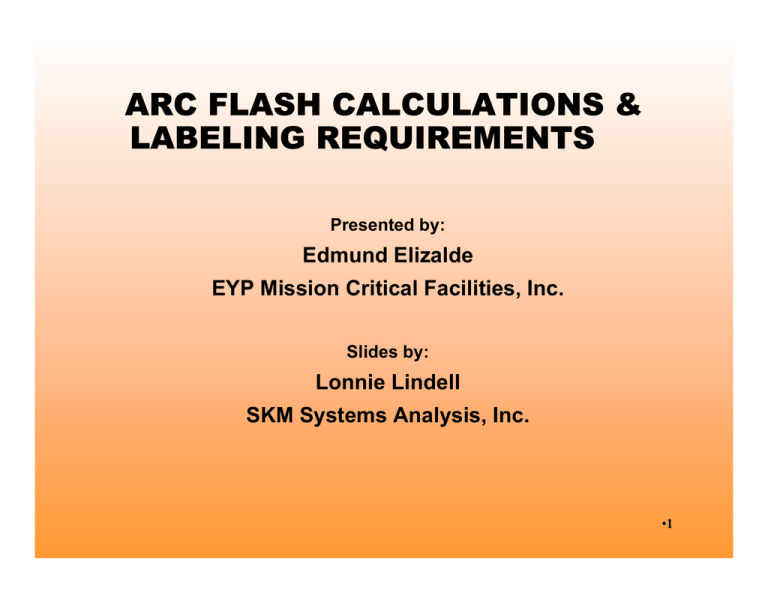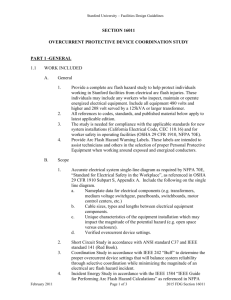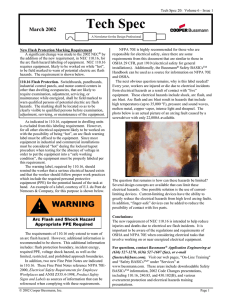Arc Flash Calculations - Critical Facilities Round Table
advertisement

ARC FLASH CALCULATIONS & LABELING REQUIREMENTS Presented by: Edmund Elizalde EYP Mission Critical Facilities, Inc. Slides by: Lonnie Lindell SKM Systems Analysis, Inc. •1 Agenda NEC 110.16 NFPA 70E IEEE Std. 1584 Arc Flash Examples Arc Flash Calculation Steps Questions & Discussion •2 Objectives Understand Code Requirements Be Aware of Hazards Know How to Read Labels •3 •NEC® 2002 Article 110.16 110.16 Flash Protection. Switchboards, panelboards, industrial control panels, and motor control centers in other than dwelling occupancies, that are likely to require examination, adjustment, servicing, or maintenance while energized, shall be field marked to warn qualified persons of potential electric arc flash hazards. The marking shall be located so as to be clearly visible to qualified persons before examination, adjustment, servicing, or maintenance of the equipment. FPN No. 1: NFPA 70E-2000, Electrical Safety Requirements for Employee Workplaces, provides assistance in determining severity of potential exposure, planning safe work practices, and selecting personal protective equipment. FPN No. 2: ANSI Z535.4-1998, Product Safety Signs and Labels, provides guidelines for the design of safety signs and labels for application to products. Reprinted from NEC® 2002 •4 •5 ! WARNING Arc Flash and Shock Hazard Appropriate PPE Required 24 inch Flash Hazard Boundary 3 cal/cm•2 Flash Hazard at 18 inches 1DF PPE Level, 1 Layer 6 oz Nomex ®, Leather Gloves Faceshield 480 VAC Shock Hazard when Cover is removed 36 inch Limited Approach 12 inch Restricted Approach - 500 V Class 00 Gloves 1 inch Prohibited Approach - 500 V Class 00 Gloves Equipment Name:Slurry Pump Starter Courtesy E.I. du Pont de Nemours & Co. •6 NFPA 70E • Requirements for safe work practices • Addresses hazards: – Shock – Arc Flash • Requirements for shock and arc flash boundaries • Requirements for personal protective equipment • Incident Energy and flash boundary calculations (<1000V, 5kA-106kA) •7 IEEE Std 1584 - 2002 • Addresses Arc Flash Calculations: Arcing Fault Incident energy Flash boundary • Valid Ranges 208 V to 15 kV 700A to 106kA Gap 13mm to 153mm • Out of Range Use Lee Equation •8 What What are are the the hazards hazards as as you you approach approach electrical electrical equipment equipment to to perform perform work? work? Bolted Short Circuit A B Arc Fault A B •10 Electrical Arc 35,000 °F Molten Metal Pressure Waves Sound Waves Shrapnel Copper Vapor: Solid to Vapor Expands by 67,000 times Hot Air-Rapid Expansion Intense Light •11 Arc Flash Incident 480 Volt System 22,600 Amp Symmetrical Fault Motor Controller Enclosure 6-Cycle Arcing Fault (0.1 sec) •20 Clothed areas can be burned more severely than exposed skin •21 Arc Flash Incident 480 Volt System 22,600 Amp Symmetrical Fault Motor Controller Enclosure Current Limiting Device with < ½ Cycle operation (.0083 sec). Note that Arcing Fault must be in current limiting range. What Are the OSHA Regulations and NFPA 70E Requirements for Working on “Live” Equipment? •29 Safe Work Practices OSHA 1910.333 (a) (1) & NFPA 70E 2-1.1.1 not to work “hot” or “live” except when: 1. De-energizing introduces additional or increased hazards 2. Infeasible due to equipment design or operational limitations •30 Equipment Flash Flash Protection Protection Boundary Boundary (FPB) (FPB) Must Must wear wear appropriate appropriate PPE PPE FPB FPB dependent dependent on on fault fault level level and and time time duration. duration. Prohibited Shock Boundary: Qualified Persons Only. PPE as if direct contact with live part Restricted Shock Boundary: Qualified Persons Only Limited Shock Boundary: Qualified or Unqualified Persons* * Only if accompanied by Qualified Person Note: shock boundaries dependent on system voltage level Incident Energy • Energy Per Unit of Area Received On A Surface Located A Specific Distance Away From The Electric Arc, Both Radiant And Convective, in Units of cal/cm2. •32 Cal/cm2 • 1.2 cal/cm2 - Second Degree Burn • 3 cal/cm2 - 1% probability ignition of light weight cotton shirt. • 6 cal/cm2 - Arc Rating of 1 layer 6 oz/yd2 aramid. • 32 cal/cm2 - Arc Rating of one layer 6 oz/yd2 plus 4.5 oz/yd2 aramid over a cotton T-shirt. •33 Highlights of changes impacting arc flash hazards PPE in the 2000 edition of NFPA70E •34 NFPA70E - 2000 Where it has been determined that work will be performed within the flash protection boundary, the flash hazard analysis shall determine, and the employer shall document, the incident energy exposure of the worker NFPA70E - 2000 This incident energy exposure level shall be based on the working distance of the employee’s face and chest areas from a prospective arc source for the specific task to be performed. 480V MCC Use IEEE 1584 Calculations Preliminary IEEE 1584 work used in NFPA 70E NFPA 70E calculations limited to < 1000V IEEE 1584 equations expanded to 15,000V NFPA 70E revision will reference IEEE 1584 Arc Flash Calculation Steps Determine System Modes of Operation Calculate Bolted Fault Current at each Bus Calculate Arcing Fault Current at each Bus Calculate Arcing Fault Current seen by each Protective Device Determine Trip Time for Each Protective Device based on Arcing Fault Current Calculate Incident Energy at Working Distance Calculate Arc Flash Boundary Determine Required PPE Generate Labels Find Appropriate PPE Find Appropriate PPE Generate Labels Summary •NEC 110.16 Requires Arc Flash Hazard Labels. •NFPA 70E Requires Documented Arc Flash Calculations. •IEEE Std 1584 Defines Arc Flash Calculations. •Arc Flash Calculations Require Accurate Fault Current Values. •Arc Flash Calculations Require Over-Current Coordination Study. Summary •Arc Flash Calculations May Require Evaluation of Multiple Operating Modes for the System. •Arc Flash Calculations Require Special Consideration For Parallel Contributions. •Arc Flash Labels may need specification of activity specific clothing levels (Line side vs Load side). Questions / Discussion Managing the hazard -Administrative controls • Operate and maintain in a way that minimizes the hazard – Site team can provide • Site procedures • Training • Process hazards analysis for electrical rooms • PPE program requirements •45 Site operating and maintenance procedures • Lock and tag – General and equipment specific • Maintenance Grounds – How? Where? When? With what? – How assure removal? • Switching – Recognize the hazard of tying two buses together and minimize the time •46 Training • What training is needed? – OSHA – NFPA 70E – Company level practices – Site specific procedures – Equipment specific (Model 7700) – Use and care of PPE •47 Process hazards analysis for ECRs, Switchyards • Get help on running analysis • What are the hazards? – Shock, arc flash, fire, fall • How can you mitigate them? – How call for help? -- Phone and FA available – Exit signs and lights – PPE available • Can you reduce the likelihood? – – – – How turn off power? -- Single lines posted Identification and warning labels Provision for locks where needed Minimize obstructions, stored material •48 Engineering Controls -Design to minimize the hazard • Reduce need for work on energized equipment • Reduce probability of three phase faults • Reduce fault current • Reduce fault duration • Reduce impact of arc flash on people • Provide information on available fault energy •49 Studies reveal all electrical injuries involve energized equipment! • Most organizations prohibit hot work, (except testing.) • Why do injuries still occur? – Testing – Racking in breakers – Operating switches and circuit breakers – Equipment failures when no work underway – Job expanded beyond original intent - #1 reason! •50 Reduce need for work on or near energized equipment • Design to enable shutdowns – Unitize loads - group by process function – Provide dual feeds to critical equipment controls – Money is always available for safety • Design for easy testing and grounding • Design for remote racking and operation • Install warning labels •51 Reduce probability of three phase faults – Metal clad vs. metal enclosed switchgear – Insulated bus – Resistance grounded system • Low resistance grounded - > 1 kV • High resistance grounded - 480 V, 400 V – Adequate ground fault return path – Connection points for ground jumpers •52 Reduce fault current • Fast current limiting fuses – Limiter fuses on 480 V feeder breakers • Resistance grounding – HRG on 480 V systems – LRG on 2.4 kV to 22 kV systems •53 Reduce fault duration • Use current limiting fuses • Tighten up the coordination • Select protective devices for people protection as well as equipment protection and reliable operation. – Select relay settings for fast trips – Select lower rated fuses – Cut possible fault energy in half •54 Reduce impact of arc flash on people • Avoid openings/vents in equipment doors – Prefer door openings at the side of the door to openings in the center • Arc resistant switchgear – Big benefit for switching • Remote operating controls for switchgear • Remote racking - 480 V and higher •55




